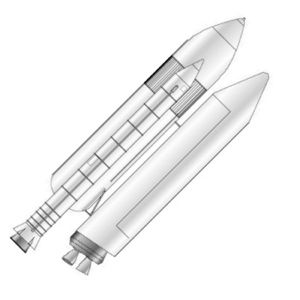
Home - Search - Browse - Alphabetic Index: 0- 1- 2- 3- 4- 5- 6- 7- 8- 9
A- B- C- D- E- F- G- H- I- J- K- L- M- N- O- P- Q- R- S- T- U- V- W- X- Y- Z
Martin Marietta SDV
 Shuttld SDV 1982 Credit: © Mark Wade |
Status: Study 1983. Payload: 61,024 kg (134,534 lb). Apogee: 300 km (180 mi).
Martin studied cargo versions of the shuttle under two-phase contract NAS8-34183. Phase I was completed in July 1981, and Phase II on 10 February 1983. The Phase I study looked at four classes of Shuttle-Derived Vehicles:
- Class I: The orbiter would be replaced by a Cargo Element (CE) consisting of an SSME propulsion and avionics package (as in the Shuttle C). Landing would be tail-first on tripod landing gear.
- Class II: Two liquid rocket boosters would replace the two liquid rocket boosters, using the manned orbiter. This would boost orbiter payload to 45,000 kg, but it was doubtful that a payload of this mass could fit in the shuttle cargo bay.
- Class III combined the Class I CE with the Class II LRB's. Payload to orbit would be increased to 113,000 kg.
- Class IV would be as Class III, but with the SSME engines moved to the base of the External Tank (essentially the configuration used by the Russian Energia booster). But this had no payload improvement compared to Class III.
Phase II studies refined these concepts somewhat:
- Class I: As earlier, but with a larger payload canister
- Class II: As Class III before, but with more detailed engineering analysis of what would be needed to realize the design. Payloads of 4.6 m diameter x 27.4 m long or 7.6 m diameter x 28 m long could be accommodated, up to a maximum of 68,000 kg. The smaller payload module would be available by 1985, the larger by 1987. Recoverable engine pod ballistics and aerodynamics were refined, resulting a hypersonic L/D of 0.19 for recovery. Landing was revised to a horizontal landing on 4 impact skids. The basic design could achieve the same cross range as the winged shuttle if 4500 kg of propellant were carried for orbital plane changes. Alternatively, a lifting body design with a hypersonic L/D of 0.8 could be used.
- Class IA: This version would have the podded engines but no recovery provisions or in-orbit propulsion package. The payload would be placed in a higher orbit and the engine pod remain there until recovered in a later shuttle mission.
- Class II Liquid Rocket Boosters: Each of 4 to 5 LRB's would be powered by a single SSME engine, and be 6.1 m in diameter and 31.7 m long. T/W at liftoff would be 1.122:1. Replacement of the liquid hydrogen with liquid methane or propane was studied in order to achieve a higher density, reducing the number of LRB's (but increasing the number of SSME's per booster).
- Class I with uprated SSME's (130% of standard thrust, and using a 6:1 oxidizer/fuel ratio instead of 6.76:1). This would require a 1.22 m stretch of the External Tank, adding 717 kg to the dry weight of the tank. Payload would increase from 61,024 kg to 91,662 kg to a 300 km, 28.5 deg orbit.
- ET ACC (Aft Cargo Carrier). Study of heavy-lift improvements to the shuttle using the shuttle orbiter showed that most payloads were volume-limited - e.g. even though the shuttle could be provided with double the payload, such a payload could not be fitted into the shuttle-orbiter's fixed-size payload bay. Therefore it was proposed that an Aft Cargo Carrier be fitted to the base of the External Tank. This would be 8.5 m long and 7.6 m in diameter. It would increase the External Tank's mass by 1500 kg, but would allow bulky payloads like the planned OTV Orbit Transfer Vehicle to be carried into orbit together with a shuttle and a full load in its payload bay.
LEO Payload: 61,024 kg (134,534 lb) to a 300 km orbit at 28.50 degrees.
Family: orbital launch vehicle, Winged. Country: USA. Agency: Martin.
Back to top of page
Home - Search - Browse - Alphabetic Index: 0- 1- 2- 3- 4- 5- 6- 7- 8- 9
A- B- C- D- E- F- G- H- I- J- K- L- M- N- O- P- Q- R- S- T- U- V- W- X- Y- Z
© 1997-2019 Mark Wade - Contact
© / Conditions for Use